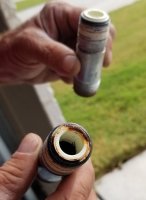Jadnashua
Retired Defense Industry Engineer xxx
That valve with a grey knob is a tempering valve...it is used to set the maximum water temperature to be fed to the house. It is independent of the setting on the WH. It allows the WH to be set to a higher temperature if you wish to provide more hot water and to ensure it gets hot enough to kill anything without scalding you if you had full hot turned on somewhere by mixing in some cold to temper the output to where you set it. Where I live, one is required, and they're a good idea anywhere. WHere I live, they also require an expansion tank, and they can be a good idea, depending on what the supply system has in it.
A check valve prevents water from the house pushing back into the supply line, and potentially polluting the water in the neighborhood. Worst case scenario...your hose is sitting in a puddle in the yard and there's a hiccup in the pressure sucking in dog poop, insecticides, and maybe fertilizer when they open up a fire hydrant down the street to fight a fire, dropping the pressure. Yes, it's not a common situation, but it can and has happened...a working check valve will prevent that, but also means when the WH operates, there's no place for that larger volume of water to go unless you have an expansion tank. The pressure spikes almost immediately since the water is not compressible nor are the pipes very elastic. The bladder in the ET can compress easily, and absorb that expanding water without spiking the pressure.
Without some plastic/rubber lined hoses somewhere in the hot lines, can't think of any common sources of black specs that aren't also in the cold lines (i.e., exclusive to the hot supply), especially when they are at all outlets. It obviously has to be in some common line unique to the hot supply. I don't know of any WH that has rubber components inside of them, but then, I've not taken any apart. Haven't heard of anyone reporting them coming from inside of the WH.
If they were hard, like grains of sand, it could be some precipitate created by heating the water, but I think you implied they were oily, which implies rubber/plastic as the source.
A check valve prevents water from the house pushing back into the supply line, and potentially polluting the water in the neighborhood. Worst case scenario...your hose is sitting in a puddle in the yard and there's a hiccup in the pressure sucking in dog poop, insecticides, and maybe fertilizer when they open up a fire hydrant down the street to fight a fire, dropping the pressure. Yes, it's not a common situation, but it can and has happened...a working check valve will prevent that, but also means when the WH operates, there's no place for that larger volume of water to go unless you have an expansion tank. The pressure spikes almost immediately since the water is not compressible nor are the pipes very elastic. The bladder in the ET can compress easily, and absorb that expanding water without spiking the pressure.
Without some plastic/rubber lined hoses somewhere in the hot lines, can't think of any common sources of black specs that aren't also in the cold lines (i.e., exclusive to the hot supply), especially when they are at all outlets. It obviously has to be in some common line unique to the hot supply. I don't know of any WH that has rubber components inside of them, but then, I've not taken any apart. Haven't heard of anyone reporting them coming from inside of the WH.
If they were hard, like grains of sand, it could be some precipitate created by heating the water, but I think you implied they were oily, which implies rubber/plastic as the source.

